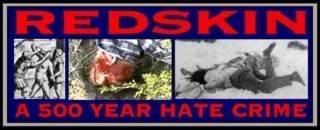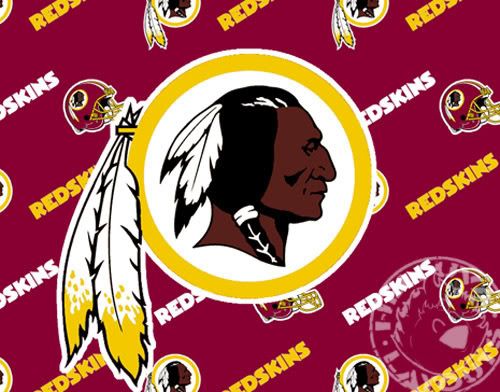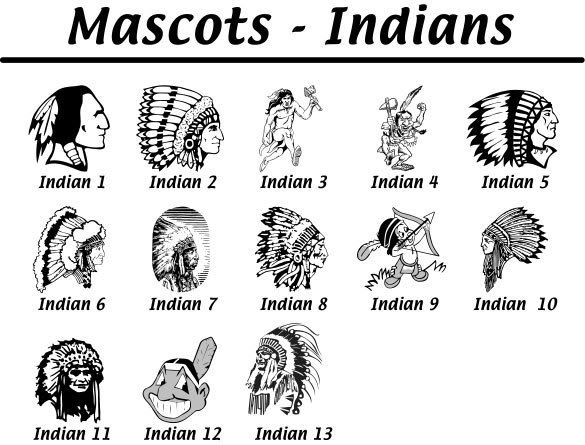Source
The Indian removals which destroyed one quarter of the Cherokee tribe, were actually conceptualized by Jefferson and then extended and carried out by Jackson. There were great debates about whether the “redskins” were human and whether they had souls.
I heard a descendant of Moxtaveto (Black Kettle), speak about the racism of Sports Mascots. She said the focus was on the name "Redskins." She went on to explain how, after American Indians were mutilated and exterminated, the name used to refer to the mutilated American Indian was "Redskin." As if anyone thinks the killers said anything that would indicate the reality of what they had done at the time. "Redskin" was a term used to dehumanize and enable the genocide.
Source
REDSKIN A 500 YEAR HATE CRIME,
is being used in educational presentations throughout the United States to effectively reveal the history of racial and religious hatred behind the term Redskin Indians and clearly shows the harm brought by ridiculing minorities. It is appropriate for adults and children in middle school or older.
Disgustingly so, “Redskin Indians” refers to literally skinning American Indians. “But his (Jackson’s) Indian Fighters had a very peculiar preoccupation, that was skinning the Indians on the battlefield. They used to make pants” it says in the video. Reverend Goat Carson, who is “Internationally recognized for his presentations,” discusses it in “REDSKIN A 500 YEAR HATE CRIME.”
Source
Telling it like it is Reverend Goat cuts through the barriers created by America's history books. "REDSKINS" makes human beings out of the Indian children and elders who were mutilated and skinned for their religious and racial heritage.
Furthermore, if anyone doubts that manifestations of that hate are less than current, I relate the following.
PORTLAND -- The FBI is investigating recent posts on craigslist that offered to sell "Maine Indian scalps" to "white people only," according to court documents and the leader of the Penobscot Indian Nation, who reported the situation to state and federal officials.
The person who posted the items claimed to have six scalps and related artifacts that were obtained by bounty hunters in the 1700s and came into his possession through a private family collection.
- snip –
"Even if it is hair, with a little bit of flesh on it, that is human remains. That could be one of our ancestors," Mitchell said. "This doesn't just affect people in the past. It affects us today, people who are living."

So one last time, "Redskin Indians" refers to literally skinning American Indians. "But his (Jackson's) Indian Fighters had a very peculiar preoccupation, that was skinning the Indians on the battlefield. "They used to make pants" it says in the video.

It goes on to say “they’d be able to take an Indian and skin him from the hip down and make themselves a pair of pants.” Next, it talks about how they made reins for their bridle to ride their horses and that “redskins” became a joke. Hence, "the depth and pervasiveness of the racism against Indigenous Peoples so deeply engrained in the history and psyche of the United States and the dominant culture."
One last time, "Redskin" was a term used to dehumanize and enable genocide.
What the Consolidated Indigenous Shadow Report says about Indian Mascots on page 72.
Although the United States would probably respond that racist mascots and logos are an exercise of free speech that it has reserved under the Convention, they reveal the depth and pervasiveness of the racism against Indigenous Peoples so deeply engrained in the history and psyche of the United States and the dominant culture.

Labels: Native Americans, racism, winter rabbit
Ahistoricality on 10/01/2009 4:01 PM:
That is interesting: WR, she's talking about the early use of "red" to designate native Americans, arising out of Southeastern color symbology and the need for an alternative within the white-black racialism of the Europeans -- or, which she offers as an alternative, arising out of other regions origins stories and ritual practices, especially face-painting. It's kind of inconclusive, actually, which might well be the "some flaws" Andrew's pointing to. On the question you address above, she's mostly silent, though her conclusion says "Indians may have named themselves "red," but they could not prevent whites from making it a derogatory term. By the nineteenth century, whites had appropriated "red man" and put it to their own uses. Appearing in the novels of James Fenimore Cooper, captivity narratives, and dime novels, ultimately to be taken up by tobacco advertisers and national sports teams, the noble "Red Man" and the brutal "Redskin" evolved into demeaning and dehumanizing racial epithets. But, at the same time, Indians could always use "red" to claim a positive identity and to make a statement about difference, to build pan-Indian alliances as in the native women's organization Women of All Red Nations, or to articulate American Indian grievances as in Vine Deloria, Jr.'s critique of Euroamerican ethnocentrism, God Is Red (1973)." (p. 643)
Winter Rabbit on 10/01/2009 9:59 PM:
Indeed it is interesting Ahistoricality, and you got me thinking since your post goes along the timeline. Not every single first contact was violence. For example, Lewis and Clark. But there had to be a way to differentiate, and "other regions origins stories and ritual practices, especially face-painting" makes sense in that light, but not conclusive, because it leaves out the bleeding aspect when the violence did begin at various points - the discovery of natural resources at different times and places. The inconclusiveness also seems to come from the fact that while there were some friendly first contacts, the friendliness was an obvious deception when treaties were a result of the "friendliness." What I'm saying is, she seems to be oversimplifying. A + B therefore A, but we need B to see the entire picture.
As far as the Indians naming themselves "Red," the Medicine Wheel having colors is a relatively new phenomenon. When red was added into the Wheel, it wasn't about race, it was about which direction red was in the sky as the sun rose or set (can't remember if he said dusk or dawn, should've written it down). That's why you'll see some Wheels with red in the North, and some in the South. But certainly Indians referred to "Whites," so I don't know. I'm inconclusive myself.
I apparently loaned my copy of "God Is Red" permanently, but that is spot on: "or to articulate American Indian grievances as in Vine Deloria, Jr.'s critique of Euroamerican ethnocentrism."
I think if we're ever going to eradicate the name to the point similar names have been, that understanding all its origins are pieces of the puzzle we can't afford to leave out. All I have now are more questions.
Ahistoricality on 10/02/2009 12:57 PM:
Credit where credit is due: I was quoting Shoemaker.
One of the points she makes is that the use of "red" as a designator for Native Americans is not about skin color, and actually comes out of Native American linguistics and practice (I don't remember a reference to the Medicine Wheel, specifically), not European: she presents considerable evidence that the Europeans who described Native Americans before the widespread use of "red man" never described them as anything but various shades of brown. It's kind of an interesting thing: the creation of the term, which was more cultural than racial, actually affected people's perceptions of reality.....
Shoemaker is explicitly talking about contacts early enough that violence and dislocation aren't yet significant issues, and clearly she considers "redskin" to be "brutal" -- which suggests to me, though she didn't cite anything, that she'd agree with the original post here regarding its etymology and import.






There's an excellent article called "How Indians Got to Be Red" by Nancy Shoemaker [AHR, 102:3. June 1997] that discusses the evolution of the use of skin color as a designation for Native Americans.
Though I think it has some flaws, it's an excellent piece for helping us to think about some of these issues.